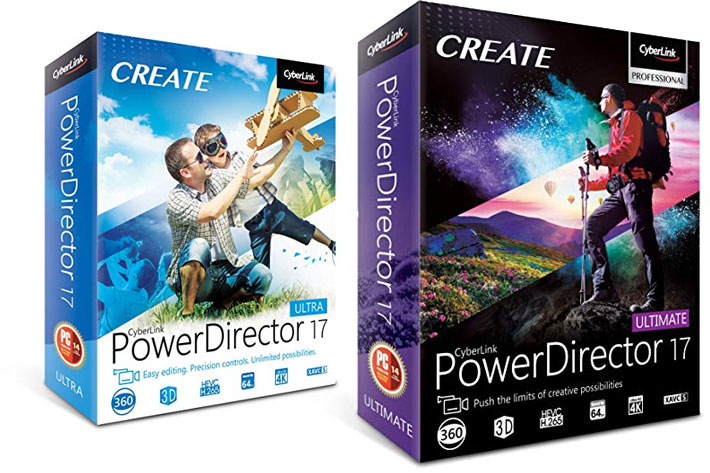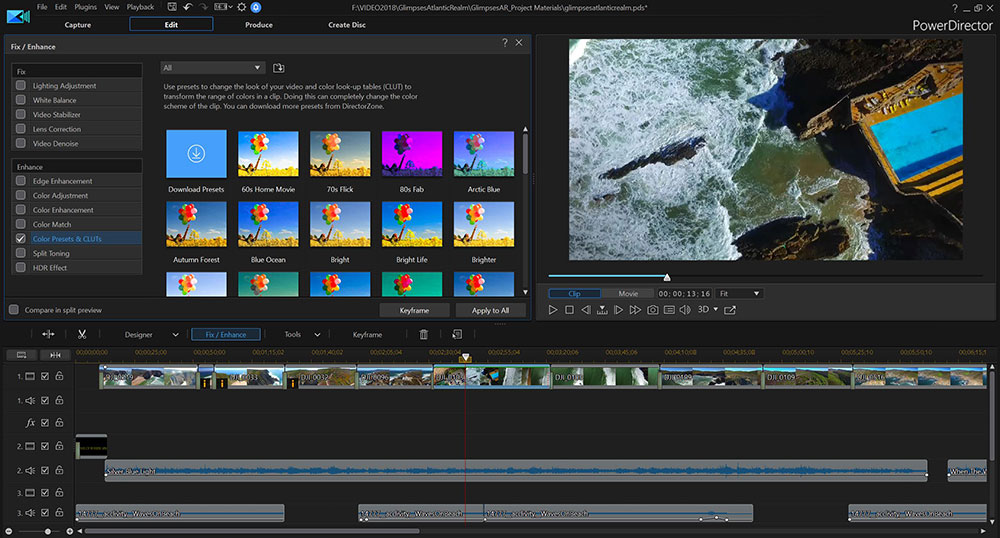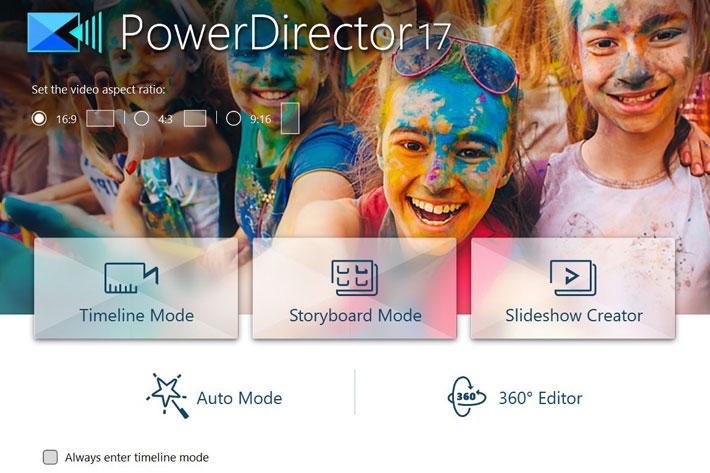
With so many FREE options in terms of NLEs, it was only a matter of time until CyberLink decided to offer a FREE version of PowerDirector. It’s available now, together with a new subscription model.
Which NLE is more popular? Which is easier to use? Which NLE certification would be most valuable? Which NLE do you use?
The questions above may all have different answers, depending not only who you ask, but in which area of the industry they work, and, strangely as it may sound, also depending on the region they live in, and sometimes the country or part of the world where they live. All these questions, some suggestions and many opinions have appeared here at ProVideo Coalition in recent months, in a series of articles written by PVC’s Editor Scott Simmons.
Because I believe you’ll want to read the whole series, let me point you to the different articles. October 11 Scott wrote “Which non-linear editing application should a graduating high school senior be certified for?”, followed, on October 17, by “Adobe releases Premiere Rush, the easy, cross-platform video editor that may not be made for you”. Finally, November 14 he published “DaVinci Resolve 15.2 update continues Blackmagic’s march toward post-production dominance”.

Searching for an NLE with an easy interface
The titles for these articles, despite the fact that they all are about NLEs, do not suggest there is a deep connection between them, but there is: they all go back to the continued quest after the “best” editor, the easier to learn, how the word “FREE” has changed perspectives. From Resolve’s “march toward post-production dominance” to Adobe’s Premiere Rush, developed with YouTube creators in mind, the articles and the comments that they originated are interesting material to read, for what they reveal about the actual state of the industry.
Reading both articles and comments I felt there was a common tone: the suggestion that a NLE with an interface easy enough for most people to quickly edit would be welcome addition to the actual line up of video editors. Adobe’s Rush, which Scott Simmons compares to the old Adobe Premiere Clip, “but better” is not what most have in mind. On the other hand, despite the fact that Resolve is, as Scott writes, on a “march toward post-production dominance”, and has a FREE version, its interface has the “steepest learning curve followed by Avid and then Premiere and FCPX” according to a comment made by Lou Hemsey.

My experience with NLEs
Although I agree that Resolve is not easy to grasp, I also believe that “learning curves” are more or less steep depending on where you come from, and in my case, having tried to use Resolve’s, I must say that not even the fact that it is FREE has helped much. In fact, and that’s me, my experience with NLEs has not been an easy one: I’ve tried and even edited in HitFilm Express, I’ve used Premiere Pro, tried Lightworks, DaVinci Resolve and a series of other software, many not present in the “most popular list”, and I tend to go back to the same video editor: PowerDirector, from CyberLink.
I promised myself that 2018 was the year to learn Resolve, but we’re running through the last days of December and I recently installed PowerDirector 17, which I’ve used to edit the video present here and the video used on my hands-on of the Fujifilm X-T3. CyberLink’s NLE was launched recently, and I could not resist exploring this new version. Again! Meanwhile, Resolve’s shortcut is quietly waiting on my desktop.
From a slide show editor to a video editor
There is a reason for me to go back to PowerDirector when I want to edit video: it offers me all I need to build my narratives, and its interface, made for video editing, is not very different from the one I am faced with when I open my slideshow creator, ProShow Producer, from Photodex. I’ve used both programs for over a decade now, so I am familiar with their respective interfaces, and that explains why I keep using them and do not feel the need to change.
I first tried PowerDirector in 2005 and in 2007, with version 6.0, it became my regular NLE. Users of “professional” NLEs have asked me why I don’t use something else and any reply has to include my background. Coming from photography, a relation that goes back to the 70s of last century, my use of video started, effectively, when DSLRs offered the option to create moving images. Despite the fact that I used film and essentially videotape, writing about camcorders back in the 90s, video always took second place.
The new PowerDirector 17
PowerDirector came as a product to test and write about and as the resulting video made me happy, I just kept using it. As I’ve written earlier, the interface, although following the same logic, I believe, as other NLEs, is so much familiar to me that whenever I need to create content, PowerDirector’s shortcut is the one I look at. It’s as simple as that! So, having explained my choice, and the reasons why I don’t see why I should change, let’s look at what this new version introduces.
With this version CyberLink explores two new options: a free version and a subscription model PowerDirector 365, which the company also introduced, recently, for its PhotoDirector 10, available also as PhotoDirector 365. The two models – subscription or perpetual license – continue to be available, with the subscription model being, according to the company “the ideal solution for advanced video creators who want to always have access to the latest and most advanced tools.”
There is a FREE version too
There is also a FREE version, named PowerDirector Essential, which users can download and try for 30 days with all the Premium features. When the trial ends, only essential functions are available, and videos are limited to 720p. It’s, no doubt, less than what other NLEs offer – DaVince Resolve comes to mind – but I believe that for many users it will be enough, specially because of the price paid and the user friendly interface the program offers.
Having used and reviewed PowerDirector before, the PowerDirector 17 version does not seem much different to me. The interface is essentially the same, and while I believe some of the menus could probably be changed for something less colorful and more “professional”, I understand that they’re designed with a purpose: to make things easier for newcomers. The fact is that once you know your way around the tools – and believe me, there is a lot to explore – the video editor works, taking you from the timeline all the way to producing files for online distribution or even creation of DVDs and more.
New features in PowerDirector 17
CyberLink says the improved Video Collage Designer can combine up to seven videos simultaneously, with animated openings and endings. Express Projects, one-click color correction tools, and the easy-to-use Action Camera Center make editing any video project a breeze, adds the company, and while those and other magic tools are available, if you want to control things on your own, you’re welcome to it. That’s how I use the program, although I believe other users will want to explore other ways to get their stories told.
Video editors who want to push boundaries can explore PowerDirector’s 360° stabilization technology and editing tools. New for this version are features like Nested Projects for timeline editing and Video Pre-cut help to streamline the creative process. Professional editors can now take greater control of the creative process with frame-by-frame motion tracking, multi-key sampling for chroma key editing and a host of other tweaks to PowerDirector’s design tools.
NewBlueFX, proDAD, BorisFX
On top of the base program with all its functions, including a multi-cam feature that some will want to explore, PowerDirector 17 brings a large and growing collection of professional effects, templates and add-ons, including, on the 365 version, a large and growing collection of professional effects, templates and add-ons, including all the AI Style Packs exclusive to CyberLink and 50GB of cloud storage. It also includes, in the Ultra version, a selection of add-ons exclusive to CyberLink, in addition to professional tools from NewBlueFX, proDAD, and BorisFX.
The Ultra version of the program continues to be the benchmark that combines the essential features – everything you need to edit video, in fact. As CyberLink says, it offers “simplified editing tools” that allow for “rapid movie creation and eliminate the steep learning curve usually associated to video editing.” I believe that’s a key element that will appeal to many users. For me it just felt as an extension of the slideshow editor I use – ProShow Producer – and that has contributed, as I wrote above, to make me keep using it. In that sense I’ve to agree with CyberLink, when the company says that “while it continues to exceed the needs and expectations of casual users, this new release (of PowerDirector) introduces a number of professional-level features that will satisfy the most advanced video creators.”
Choose your version
The program is available from CyberLink online store and in selected retail outlets worldwide in the following languages: English, French, German, Italian, Spanish, Dutch, Chinese (Simplified and Traditional), Japanese and Korean. The PowerDirector 365 subscription costs $69.99 for 12 months and includes PowerDirector 17, unlimited access to CyberLink premium add-ons and content packs include AI Style Packs and 50GB CyberLink Cloud storage. In terms of perpetual license, the choices are the PowerDirector 17 Ultimate ($129.99) or PowerDirector 17 Ultra ($99.99). If you’re after a photo editor as well, CyberLink has a special package that includes PowerDirector 17 & PhotoDirector 10 for $139.99.
To try any software, there is nothing better than to have a project to work on. The video published here was edited using PowerDirector 17 and it reflects my experience with this version of the program. In fact, I also used PowerDirector 17 to create a previous video, for the Fujifilm X-T3 hands-on article. Although I started to work on the video with the previous version of the NLE, I moved to the new version to finish it.
My son’s drone footage
The video used here is just a collage of a sequence of aerial video captures created by my son João back in 2017, when he attended a short workshop on drone piloting and image capture. We’ve had the footage in a hard drive, waiting for a reason to use it, and I felt it made sense to create this project to share with friends and family at this time of the year. The video shows the raw clips selected in a sequence so as to reveal a section of the Atlantic Ocean coast, edited, and with transitions included.
From all the footage available I picked the sequences that cover areas I’ve walked since the 70s as a photographer, and that I call the Atlantic Realm, a clear reference, for me at least, to the album of the Irish folk group Clannad, released in 1989, which is the soundtrack to the BBC television series The Natural World: Atlantic Realm, a documentary about the Atlantic Ocean.
From ultralight to drone view
Although I’ve flown over some areas of this coast as a passenger on an ultralight, to photograph, the freedom a drone gives is completely different, as this video documents. Since I first saw João’s videos I’ve said it excited me to see not only the perspective from above, and the freedom given by the bird’s eye perspective, but also his choice of angles, which helps to share the fantastic coastal landscapes close to where we live. I had dreamed about some of the options in terms of framing, seeing the place through my son’s eyes is an exciting experience, as it was to edit the footage to create this video.
I’ve added here some of my photographs of the same areas, taken from the ground, to complete the story. In terms of the video, it took a while to get the right music and sounds to go along with the footage captured from a noisy drone. I would say that getting those elements to work with the images is, many times, what takes longer in a project like this. Sound is essential in a multimedia experience, and you’ll find in PowerDirector the tools to edit and mix sound so it works as a whole. If you want to take things further, in terms of image and sound, CyberLink has two other programs that work with PowerDirector 17: AudioDirector and ColorDirector.
Final notes
The illustrations used in this text show some aspects of the interface, but the best way to understand what PowerDirector 17 is capable of doing is by downloading the software to try it. If you’re after an easy to use solution for 2019, give it a try. After all, even if you decide not to buy it, the FREE version will give you the essential tools of a NLE, even if the output is limited to 720p. Maybe with the next edition of the program CyberLink will dare to go to Full HD on the FREE version. With so many other FREE options, it may well be a good strategy.

